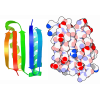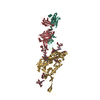[English] 日本語
 Yorodumi
Yorodumi- PDB-6vfl: BG505-SOSIP model reconstructed by subparticle extraction and ref... -
+ Open data
Open data
- Basic information
Basic information
| Entry | Database: PDB / ID: 6vfl | |||||||||
|---|---|---|---|---|---|---|---|---|---|---|
| Title | BG505-SOSIP model reconstructed by subparticle extraction and refinement from a tetrahedral nanoparticle T33_dn10 | |||||||||
 Components Components |
| |||||||||
 Keywords Keywords | DE NOVO PROTEIN / Nanoparticle / Rosetta / De novo protein design / HIV Env | |||||||||
| Biological species | synthetic construct (others) | |||||||||
| Method | ELECTRON MICROSCOPY / single particle reconstruction / cryo EM / Resolution: 4.14 Å | |||||||||
 Authors Authors | Antanasijevic, A. / Ward, A.B. | |||||||||
| Funding support |  United States, 1items United States, 1items
| |||||||||
 Citation Citation |  Journal: PLoS Pathog / Year: 2020 Journal: PLoS Pathog / Year: 2020Title: Structural and functional evaluation of de novo-designed, two-component nanoparticle carriers for HIV Env trimer immunogens. Authors: Aleksandar Antanasijevic / George Ueda / Philip J M Brouwer / Jeffrey Copps / Deli Huang / Joel D Allen / Christopher A Cottrell / Anila Yasmeen / Leigh M Sewall / Ilja Bontjer / Thomas J ...Authors: Aleksandar Antanasijevic / George Ueda / Philip J M Brouwer / Jeffrey Copps / Deli Huang / Joel D Allen / Christopher A Cottrell / Anila Yasmeen / Leigh M Sewall / Ilja Bontjer / Thomas J Ketas / Hannah L Turner / Zachary T Berndsen / David C Montefiori / Per Johan Klasse / Max Crispin / David Nemazee / John P Moore / Rogier W Sanders / Neil P King / David Baker / Andrew B Ward /    Abstract: Two-component, self-assembling nanoparticles represent a versatile platform for multivalent presentation of viral antigens. Computational design of protein nanoparticles with differing sizes and ...Two-component, self-assembling nanoparticles represent a versatile platform for multivalent presentation of viral antigens. Computational design of protein nanoparticles with differing sizes and geometries enables combination with antigens of choice to test novel multimerization concepts in immunization strategies where the goal is to improve the induction and maturation of neutralizing antibody lineages. Here, we describe detailed antigenic, structural, and functional characterization of computationally designed tetrahedral, octahedral, and icosahedral nanoparticle immunogens displaying trimeric HIV envelope glycoprotein (Env) ectodomains. Env trimers, based on subtype A (BG505) or consensus group M (ConM) sequences and engineered with SOSIP stabilizing mutations, were fused to an underlying trimeric building block of each nanoparticle. Initial screening yielded one icosahedral and two tetrahedral nanoparticle candidates, capable of presenting twenty or four copies of the Env trimer. A number of analyses, including detailed structural characterization by cryo-EM, demonstrated that the nanoparticle immunogens possessed the intended structural and antigenic properties. When the immunogenicity of ConM-SOSIP trimers presented on a two-component tetrahedral nanoparticle or as soluble proteins were compared in rabbits, the two immunogens elicited similar serum antibody binding titers against the trimer component. Neutralizing antibody titers were slightly elevated in the animals given the nanoparticle immunogen and were initially more focused to the trimer apex. Altogether, our findings indicate that tetrahedral nanoparticles can be successfully applied for presentation of HIV Env trimer immunogens; however, the optimal implementation to different immunization strategies remains to be determined. | |||||||||
| History |
|
- Structure visualization
Structure visualization
| Movie |
 Movie viewer Movie viewer |
|---|---|
| Structure viewer | Molecule:  Molmil Molmil Jmol/JSmol Jmol/JSmol |
- Downloads & links
Downloads & links
- Download
Download
| PDBx/mmCIF format |  6vfl.cif.gz 6vfl.cif.gz | 378.3 KB | Display |  PDBx/mmCIF format PDBx/mmCIF format |
|---|---|---|---|---|
| PDB format |  pdb6vfl.ent.gz pdb6vfl.ent.gz | 313.5 KB | Display |  PDB format PDB format |
| PDBx/mmJSON format |  6vfl.json.gz 6vfl.json.gz | Tree view |  PDBx/mmJSON format PDBx/mmJSON format | |
| Others |  Other downloads Other downloads |
-Validation report
| Summary document |  6vfl_validation.pdf.gz 6vfl_validation.pdf.gz | 3.1 MB | Display |  wwPDB validaton report wwPDB validaton report |
|---|---|---|---|---|
| Full document |  6vfl_full_validation.pdf.gz 6vfl_full_validation.pdf.gz | 3.1 MB | Display | |
| Data in XML |  6vfl_validation.xml.gz 6vfl_validation.xml.gz | 58.6 KB | Display | |
| Data in CIF |  6vfl_validation.cif.gz 6vfl_validation.cif.gz | 88.2 KB | Display | |
| Arichive directory |  https://data.pdbj.org/pub/pdb/validation_reports/vf/6vfl https://data.pdbj.org/pub/pdb/validation_reports/vf/6vfl ftp://data.pdbj.org/pub/pdb/validation_reports/vf/6vfl ftp://data.pdbj.org/pub/pdb/validation_reports/vf/6vfl | HTTPS FTP |
-Related structure data
| Related structure data |  21186MC  6vfkC C: citing same article ( M: map data used to model this data |
|---|---|
| Similar structure data |
- Links
Links
- Assembly
Assembly
| Deposited unit | 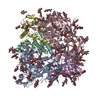
|
|---|---|
| 1 |
|
- Components
Components
| #1: Protein | Mass: 56863.668 Da / Num. of mol.: 3 Source method: isolated from a genetically manipulated source Source: (gene. exp.) synthetic construct (others) / Plasmid: pPPI4 / Cell line (production host): HEK293F / Production host:  Homo sapiens (human) Homo sapiens (human)#2: Protein | Mass: 17198.387 Da / Num. of mol.: 3 Source method: isolated from a genetically manipulated source Source: (gene. exp.) synthetic construct (others) / Plasmid: pPPI4 / Cell line (production host): HEK293F / Production host:  Homo sapiens (human) Homo sapiens (human)#3: Polysaccharide | Source method: isolated from a genetically manipulated source #4: Polysaccharide | 2-acetamido-2-deoxy-beta-D-glucopyranose-(1-4)-2-acetamido-2-deoxy-beta-D-glucopyranose Source method: isolated from a genetically manipulated source #5: Sugar | ChemComp-NAG / Has ligand of interest | N | Has protein modification | Y | |
|---|
-Experimental details
-Experiment
| Experiment | Method: ELECTRON MICROSCOPY |
|---|---|
| EM experiment | Aggregation state: PARTICLE / 3D reconstruction method: single particle reconstruction |
- Sample preparation
Sample preparation
| Component | Name: BG505-SOSIP reconstructed from the tetrahedral nanoparticle T33_dn10 by subparticle extraction and refinement Type: COMPLEX Details: Nanoparticle is assembled by combining equimolar amounts of BG505-SOSIP-T33_dn10A and T33_dn10B and subsequent incubation. EM map of the full nanoparticle can be found elsewhere (D_ ...Details: Nanoparticle is assembled by combining equimolar amounts of BG505-SOSIP-T33_dn10A and T33_dn10B and subsequent incubation. EM map of the full nanoparticle can be found elsewhere (D_1000246183). Signal originating from the nanoparticle was subtracted and BG505-SOSIP antigens are extracted as independent subparticles Entity ID: #1-#2 / Source: MULTIPLE SOURCES | |||||||||||||||
|---|---|---|---|---|---|---|---|---|---|---|---|---|---|---|---|---|
| Molecular weight | Units: MEGADALTONS / Experimental value: NO | |||||||||||||||
| Source (natural) | Organism: synthetic construct (others) | |||||||||||||||
| Source (recombinant) | Organism:  Homo sapiens (human) / Strain: HEK293F / Plasmid: pPPI4 Homo sapiens (human) / Strain: HEK293F / Plasmid: pPPI4 | |||||||||||||||
| Buffer solution | pH: 7.4 / Details: TBS buffer, pH 7.4 | |||||||||||||||
| Buffer component |
| |||||||||||||||
| Specimen | Conc.: 1.6 mg/ml / Embedding applied: NO / Shadowing applied: NO / Staining applied: NO / Vitrification applied: YES Details: Nanoparticle is assembled by combining equimolar amounts of BG505-SOSIP-T33_dn10A and T33_dn10B and subsequent incubation. Nanoparticle is purified from unassembled components by SEC. Sample ...Details: Nanoparticle is assembled by combining equimolar amounts of BG505-SOSIP-T33_dn10A and T33_dn10B and subsequent incubation. Nanoparticle is purified from unassembled components by SEC. Sample is then concentrated to 1.6mg/ml in TBS buffer. | |||||||||||||||
| Specimen support | Grid material: COPPER / Grid mesh size: 400 divisions/in. / Grid type: Quantifoil R2/1 | |||||||||||||||
| Vitrification | Instrument: FEI VITROBOT MARK IV / Cryogen name: ETHANE / Humidity: 100 % / Chamber temperature: 283 K Details: Blotting time varied in the 3-7 s range, Blotting force set to 0, Wait time of 10s. |
- Electron microscopy imaging
Electron microscopy imaging
| Experimental equipment |  Model: Talos Arctica / Image courtesy: FEI Company |
|---|---|
| Microscopy | Model: FEI TALOS ARCTICA |
| Electron gun | Electron source:  FIELD EMISSION GUN / Accelerating voltage: 200 kV / Illumination mode: FLOOD BEAM FIELD EMISSION GUN / Accelerating voltage: 200 kV / Illumination mode: FLOOD BEAM |
| Electron lens | Mode: BRIGHT FIELD / Nominal magnification: 36000 X / Nominal defocus max: 2000 nm / Nominal defocus min: 600 nm / Cs: 2.7 mm / C2 aperture diameter: 70 µm / Alignment procedure: COMA FREE |
| Specimen holder | Cryogen: NITROGEN / Specimen holder model: OTHER |
| Image recording | Average exposure time: 11.25 sec. / Electron dose: 49.39 e/Å2 / Detector mode: COUNTING / Film or detector model: GATAN K2 SUMMIT (4k x 4k) / Num. of grids imaged: 1 / Num. of real images: 798 |
| Image scans | Movie frames/image: 45 |
- Processing
Processing
| EM software |
| ||||||||||||||||||||||||||||||||||||
|---|---|---|---|---|---|---|---|---|---|---|---|---|---|---|---|---|---|---|---|---|---|---|---|---|---|---|---|---|---|---|---|---|---|---|---|---|---|
| CTF correction | Type: PHASE FLIPPING ONLY | ||||||||||||||||||||||||||||||||||||
| Particle selection | Num. of particles selected: 324420 Details: 81105 T33_dn10 tetrahedral nanoparticles (each carrying 4 copies of BG505-SOSIP antigen) have been 3D aligned in Relion. Particles have been aligned and refined using tetrahedral symmetry. ...Details: 81105 T33_dn10 tetrahedral nanoparticles (each carrying 4 copies of BG505-SOSIP antigen) have been 3D aligned in Relion. Particles have been aligned and refined using tetrahedral symmetry. Localized reconstruction v1.2 was then applied to extract the BG505-SOSIP trimeric subparticles, resulting in a total of 324420 starting particles. The full nanoparticle reconstruction can be found elsewhere (EMD-21185). | ||||||||||||||||||||||||||||||||||||
| Symmetry | Point symmetry: C3 (3 fold cyclic) | ||||||||||||||||||||||||||||||||||||
| 3D reconstruction | Resolution: 4.14 Å / Resolution method: FSC 0.143 CUT-OFF / Num. of particles: 84435 / Algorithm: BACK PROJECTION / Num. of class averages: 1 / Symmetry type: POINT | ||||||||||||||||||||||||||||||||||||
| Atomic model building | Protocol: RIGID BODY FIT / Space: REAL Details: Model refinement was performed by iterating between Rosetta relaxed refinement and manual refinement in Coot. | ||||||||||||||||||||||||||||||||||||
| Atomic model building | PDB-ID: 5CEZ Accession code: 5CEZ / Source name: PDB / Type: experimental model |
 Movie
Movie Controller
Controller













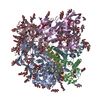



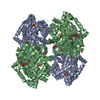
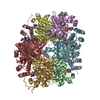
 PDBj
PDBj